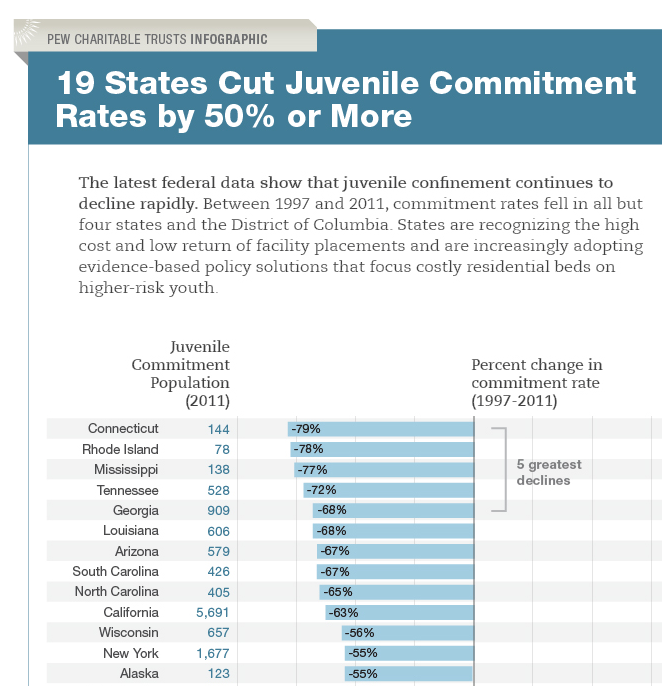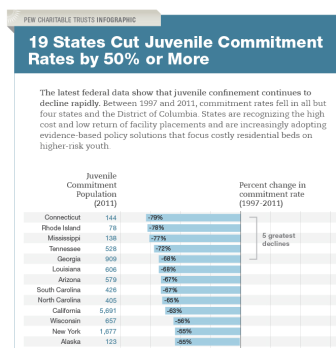According to a recent public safety performance report issued by the Pew Charitable Trusts, the juvenile commitment rate in the United States dropped by 14 percent from 2010 to 2011, with more than 40 states recording reductions in their committed youth populations over the one year period.
Nationally, the Pew Charitable Trusts say that the juvenile commitment rate has nearly decreased by half since the late 1990s, with estimated U.S. figures dropping by 48 percent from 1997 until 2011.
The report, which used statistics from the Office of Juvenile Justice and Delinquency Prevention’s Census of Juveniles in Residential Placement database, shows a marked drop in juvenile commitments between the 2006 and 2011 period. At 34 percent, the overall decrease in juvenile commitment rates was almost twice as high as the reduction rate recorded from 2001 to 2006.
“There are at least three factors contributing to the decline,” said Adam Gelb, Public Safety Performance Project director. “Some contribute it to a declining juvenile population, and some to a drop in juvenile arrests but the main factor seems to be a shift in how the court system is responding to juveniles who are arrested.”
According to Pew, several states -- among them, Connecticut, Mississippi and Rhode Island -- saw their juvenile commitment rates drop by 75 percent from 1997 until 2011, with commitment rates dropping by at least 50 percent over the same timeframe in 16 other states. Just four states and the District of Columbia saw their 2011 juvenile commitment figures surpass their estimates from 1997, the report said.
Over the past decade and a half, Gelb said that instead of sending low-level juvenile offenders to detention centers or residential facilities, more states have invested in evidence-based community programs.
“The prevailing philosophy in the 80s and 90s was that you had to lock up as many kids as possible for as long as possible, and that would be the best way to combat youth crime and violence,” he said. “But over the past dozen years or so, policymakers have been paying more and more attention to research that shows that kids are different than adults in terms of brain development and that there are more effective, less expensive ways to handle juveniles than to put them in incredibly expensive residential facilities.”
According to the report, some states may spend as much as $100,000 annually per committed juvenile offender. In total, Pew said that roughly 42,000 juvenile offenders were committed in 2011, a figure that evens out to nearly one out of every 751 young people in the United States.
“States are increasingly recognizing the high cost and low return of placing lower-risk youth in state facilities,” a Pew Charitable Trusts press release reads. “Many policymakers believe that expense would be justified if it improved public safety, but research has demonstrated that residential placements generally fail to produce better outcomes than alternative sanctions, cost much more and can actually increase re-offending for certain youth.”
Gelb cites three states -- Connecticut, Ohio and Texas -- that used three differing approaches to curb the number of youths housed in their respective juvenile facilities.
Connecticut, he said, may have lowered their juvenile commitment figures by investing in Multisystemic Therapy (MST) programming as a detention alternative, while Texas may have lowered its numbers by major statute changes, including an outright ban on sending juveniles to secured facilities for misdemeanor offenses. The program RECLAIM Ohio, Gelb said, may have lowered juvenile commitment numbers by creating fiscal incentives for counties to decrease the number of juveniles their courts send to state facilities.
“At the end of the day, the point is not to simply reduce the number of juvenile offenders in secured facilities, it’s to do that while also reducing juvenile crime,” Gelb concluded. “And those states have been successful at both.”

